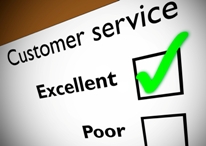Question: Let's say your business engaged in a process that was mildly annoying to your customers and provided absolutely no value. You aren't quite sure how it got started or who in your company owns it but the process continues simply out of habit. What would you do if you found about about this process?
 For many companies that gather customer satisfaction (C-Sat) data, the answer is, "We'd keep doing things the same way."
For many companies that gather customer satisfaction (C-Sat) data, the answer is, "We'd keep doing things the same way."
Sports talk radio personality Jim Rome has a favorite saying for his callers, "Give me an A or give me an F." If your company gathers C-Sat data, I hereby challenge you to do the same. Either make sure your C-Sat process earns an A, or stop wasting time and annoying customers with a process that yields no value.
How can you tell if your C-Sat process gets an A?
I propose three simple tests to get you started. This is by no means an exhaustive list, but if you answer "Yes" to these three questions you are probably doing OK.
#1 Do you know why you're asking what you're asking?
Forget your survey questions for a moment and ask, "What do I want to know?" Now, ask, "Why do I need to know that?" If you can't think of a really good reason to ask the question, don't.
I recently received a survey after getting my car's oil change that contained 36 questions (see "Customer Service Survey Mistakes to Avoid"). Does it really take 36 questions to find out if I was happy with my oil change? Of course not!
Surveys of any sort consume your customers' time. The shorter you make them, the better. As a rule of thumb, if you can't get the information you need in five questions or fewer, you are probably asking the wrong questions.
#2 Do you do anything with the data?
The whole point of capturing C-Sat data shouldn't be getting a good score. It should be using the data to improve actual customer satisfaction. If you aren't acting on the data you receive, you aren't extracting any value from the process.
In most cases, you don't have to be an expert in statistics to find value in your C-Sat data, provided you are asking good questions (see #1, above). For example, a client of mine recently grouped the comments attached to their C-Sat survey and discovered that the majority of negative feedback was attributed to one particular process. My client used this insight to fix the process and make it more customer friendly. Customer satisfaction immediately jumped and many people commented on how pleased they were with the improved process.
#3 Do you close the loop?
C-Sat instruments usually collect individual data points and combine them into an average. That's helpful for an overall score, but what do you know about each individual customer? A good system allows you to follow-up with people to either thank them for their business or fix a problem. It can be as easy as asking for their email or phone number at the end of the survey, but it's essential that you follow-up if you request this information.
Here are two examples that highlight the value of closing the loop:
A shipping company recently left a case of wine on my front doorstep. Not only did they fail to get an adult signature for the wine, they left the wine outside where the wine might have been ruined if it had been a hot day. They never asked for my opinion, so they never got my feedback. However, the next time I ordered wine from a winery that used them, I shared the story and asked the winery to use UPS instead.
One of my favorite hotels, the Napa River Inn, sent me a survey after my wife and I stayed there last year. The visit was terrific overall, but there were a few things that weren't up to their usual standards. The General Manager emailed me in response to my survey, thanked me for my feedback, and assured me she would correct the problems I had noted. She also invited me to let her know the next time I visited so she could personally ensure I had a wonderful stay. I took her up on her offer and on my next visit my wife and I had an absolutely amazing time. And, the problems we had noticed on our previous stay had clearly been corrected.


